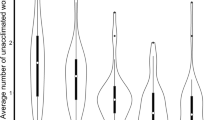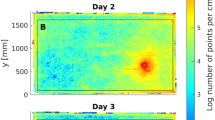Abstract
In Mediterranean habitats, temperature affects both ant foraging behaviour and community structure. Many studies have shown that dominant species often forage at lower temperature than subordinates. Yet, the factors that constrain dominant species foraging activity in hot environments are still elusive. We used the dominant ant Tapinoma nigerrimum as a model species to test the hypothesis that high temperatures hinder trail following behaviour by accelerating pheromone degradation. First, field observations showed that high temperatures (> 30°C) reduce the foraging activity of T. nigerrimum independently of the daily and seasonal rhythms of this species. Second, we isolated the effect of high temperatures on pheromone trail efficacy from its effect on worker physiology. A marked substrate was heated during 10 min (five temperature treatments from 25°C to 60°C), cooled down to 25°C, and offered in a test choice to workers. At hot temperature treatments (>40°C), workers did not discriminate the previously marked substrate. High temperatures appeared therefore to accelerate pheromone degradation. Third, we assessed the pheromone decay dynamics by a mechanistic model fitted with Bayesian inference. The model predicted ant choice through the evolution of pheromone concentration on trails as a function of both temperature and time since pheromone deposition. Overall, our results highlighted that the effect of high temperatures on recruitment intensity was partly due to pheromone evaporation. In the Mediterranean ant communities, this might affect dominant species relying on chemical recruitment, more than subordinate ant species, less dependent on chemical communication and less sensitive to high temperatures.




Similar content being viewed by others
References
Attygalle AB, Morgan ED (1983) Trail pheromone of the ant Tetramorium caespitum L. Naturwiss 70:364–365
Azcárate FM, Kovacs E, Peco B (2007) Microclimatic conditions regulate surface activity in harvester ants Messor barbarus. J Insect Behav 20:315–329
Beckers R, Deneubourg J-L, Goss S (1993) Modulation of trail laying in the ant Lasius niger (Hymenoptera: Formicidae) and its role in the collective selection of a food source. J Insect Behav 6:751–759
Bernard F (1983) Les fourmis et leur milieu en France méditerranénne. Encyclopédie Entomologique, 16, éditions Lechevalier, Paris.
Bernstein RA (1975) Foraging strategies of ants in response to variable food density. Ecology 56:213–219
Bestelmeyer BT (2000) The trade-off between thermal tolerance and behavioural dominance in a subtropical south american ant community. J Anim Ecol 69:998–1009
Blight O, Provost E, Renucci M, Tirard A, Orgeas J (2010) A native ant armed to limit the spread of the Argentine ant. Biol Inv 12:3785–3793
Brooks S, Gelman A (1997) General methods for monitoring convergence of iterative simulations. J Comput Graph Stat 7:434–455
Brown MJF, Gordon DM (2000) How resources and encounters affect the distribution of foraging activity in a seed-harvesting ant. Behav Ecol Sociobiol 47:195–203
Brown JH, Gillooly JF, Allen AP, Savage VM, West GB (2004) Toward a metabolic theory of ecology. Ecology 85:1771–1789
Bucy AM, Breed MD (2006) Thermoregulatory trade-offs result from vegetation removal by a harvester ant. Ecol Entomol 31:423–429
Cerdá X, Retana J, Bosch J, Alsina A (1989) Exploitation of food resources by the ant Tapinoma nigerrimum (Hym., Formicidae). Acta Oecol 10:419–429
Cerdá X, Retana J, Cros S (1997) Thermal disruption of transitive hierarchies in Mediterranean ant communities. J Anim Ecol 66:363–374
Cerdá X, Retana J, Cros S (1998) Critical thermal limits in Mediterranean ant species: functional trade-off between mortality risk and foraging performance. Funct Ecol 12:45–55
Chong K-F, Lee C-Y (2009) Influences of temperature, relative humidity and light intensity on the foraging activity of field populations of the longlegged ant, Anoplolepis gracilipes (Hymenoptera: Formicidae). Sociobiology 54:531–539
Cole BJ, Edwards R, Holbrook CT, Holm L, Heyward J, Wiernasz DC (2008) Does foraging activity affect foraging success in the western harvester ant (Hymenoptera: Formicidae). Ann Entomol Soc Am 101:272–276
Cole BJ, Smith AA, Huber ZJ, Wiernasz DC (2010) The structure of foraging activity in colonies of the harvester ant, Pogonomyrmex occidentalis. Behav Ecol 21:337–342
Couret H, Passera L (1979) Marquage des pistes alimentaires chez trois espèces de Dolichoderinae (Hym., Formicidae): Tapinoma erraticum (Latr.), Tapinoma nigerrimum (Nyl.) et Iridomyrmex humilis (Mayr). Ann Sci Nat (Zool) 1:39–48
Crawley MJ (2002) Statistical Computing. Wiley, Chichester
Davidson DW (1998) Resource discovery versus resource domination in ants: a functional mechanism for breaking the trade-off. Ecol Entomol 23:484–490
Deneubourg J-L, Aron S, Goss S, Pasteels JM (1990) The self-organizing exploratory pattern of the Argentine ant. J Insect Behav 3:159–168
Ellison AM (2004) Bayesian inference in ecology. Ecol Lett 7:509–520
Fellers JH (1987) Interference and exploitation in a guild of woodland ants. Ecology 68:1466–1478
Gehring WJ, Wehner R (1995) Heat shock protein synthesis and thermotolerance in Cataglyphis, an ant from the Sahara desert. Proc Natl Acad Sci U S A 92:2994–2998
Gelman A, Rubin D (1992) Inference from iterative simulation using multiple sequences. Stat Sci 7:457–511
Gillooly JF, Brown JH, West GB, Savage VM, Charnov EL (2001) Effects of size and temperature on metabolic rate. Science 293:2248–2251
Gómez C, Espadaler X (1998) Seed dispersal curve of a Mediterranean myrmecochore: influence of ant size and the distance to nests. Ecol Res 13:347–354
Gordon DM (1992) How colony growth affects forager intrusion between neighboring harvester ant colonies. Behav Ecol Sociobiol 31:417–427
Hangartner W (1969) Structure and variability of the individual odor trail in Solenopsis geminata Fabr. (Hymenoptera, Formicidae). Z vergl Physiol 62:111–120
Hefetz A, Lloyd HA (1983) Identification of new components from anal glands of Tapinoma simrothi. J Chem Ecol 9:607–613
Hölldobler B, Carlin NF (1987) Anonymity and specificity in the chemical communication signals of social insects. J Comp Physiol A 161:567–581
Hölldobler B, Wilson EO (1990) The ants. Harvard University Press, USA
Jeanson R, Ratnieks FLW, Deneubourg J-L (2003) Pheromone trail decay rates on different substrates in the Pharaoh’s ant, Monomorium pharaonis. Physiol Entomol 28:192–198
Lessard J-P, Dunn RR, Sanders NJ (2009) Temperature-mediated coexistence in temperate forest ant communities. Insect Soc 56:149–156
Lighton JRB, Turner RJ (2004) Thermolimit respirometry: an objective assessment of critical thermal maxima in two sympatric desert harvester ants, Pogonomyrmex rugosus and P. californicus. J Exp Biol 207:1903–1913
López F, Fungairiño SG, Serrano JM, Acosta FJ, Reunanen P (1997) Alloethic efficiency in the patrolling networks of a polymorphic ant, Tapinoma nigerrimum (Hymenoptera: Formicidae). J Insect Behav 10:115–127
Marsh AC (1985) Microclimatic factors influencing foraging patterns and success of the thermophilic desert ant, Ocymyrmex barbiger. Insect Soc 32:286–296
Maysov A, Kipyatkov VE (2009) Critical thermal minima, their spatial and temporal variation and response to hardening in Myrmica ants. CryoLetters 1:29–40
McDonough LM, Brown DF, Aller WC (1989) Insect sex pheromones: effect of temperature on evaporation rates of acetates from rubber septa. J Chem Ecol 15:779–790
Morgan ED (2009) Trail pheromones of ants. Physiol Entomol 34:1–17
Nicolis SC, Detrain C, Demolin D, Deneubourg J-L (2003) Optimality of collective choices: a stochastic approach. Bull Math Biol 65:795–808
Ntzoufras I (2009) Bayesian modeling using WinBugs. Wiley, USA
Ono T (1993) Effect of rearing temperature on pheromone component ratio in potato tuberworm moth, Phthorimaea operculella, (Lepidoptera: Gelechiidae). J Chem Ecol 19:71–81
Oster GF, Wilson EO (1978) Caste and ecology in the social insects. Princeton University Press, USA
Plummer M (2009) rjags: Bayesian graphical models using mcmc. R package version 1.0.3-12, http://CRAN.R-project.org/package=rjags.
Portha S, Deneubourg J-L, Detrain C (2004) How food type and brood influence foraging decisions of Lasius niger scouts. Anim Behav 68:115–122
R Development Core Team (2010) R: A Language and Environment for Statistical Computing. R Foundation for Statistical Computing, Austria
Retana J, Cerdá X (2000) Patterns of diversity and composition of Mediterranean ground ant communities tracking spatial and temporal variability in the thermal environment. Oecologia 123:436–444
Ruano F, Tinaut A, Soler JJ (2000) High surface temperatures select for individual foraging in ants. Behav Ecol 11:396–404
Savolainen R, Vepsäläinen K (1988) A competition hierarchy among boreal ants: impact on resource partitioning and community structure. Oikos 51:135–155
Simon T, Hefetz A (1991) Trail-following responses of Tapinoma simrothi (Formicidae: Dolichoderinae) to pygidial gland extracts. Insectes Soc 38:17–25
Spiegelhalter D, Best N, Gilks W, Inskip H (1996) Markov chain Monte Carlo in practice. Chapman and Hall, London
Traniello JFA (1989) Foraging strategies of ants. Ann Rev Entomol 34:191–210
Whitford WG, Bryant M (1979) Behavior of a predator and its prey: the horned lizard (Phrynosoma cornutum) and the harvester ants (Pogomyrmex spp.). Ecology 60:686–694
Wittman SE, Sanders NJ, Ellison AM, Jules ES, Ratchford JS, Gotelli NJ (2010) Species interactions and thermal constraints on ant community structure. Oikos 119:551–559
Acknowledgements
We are very grateful to Alain Lenoir for his early review of this manuscript. We thank Jean-Philippe Lessard and Ana Carvajal who helped during field ant collection, Javier Retana, Jordi Bosch, Sebastià Cros and Anna Alsina who provided the field data, two anonymous reviewers for their helpful comments and Nicolas van Oudenhove for revising the English. Doñana National Park and Sierra Nevada National Park authorities gave permission to collect ant colonies. Experimental work in EBD has been funded by Spanish Ministerio de Ciencia e Inovación (projects CGL2009-09690/BOS and CGL2009-12472/BOS). This work conforms to the legal requirements of the Spanish law.
Author information
Authors and Affiliations
Corresponding author
Additional information
Communicated by: Sven Thatje
Electronic supplementary material
Below is the link to the electronic supplementary material.
ESM_1
(PDF 661 kb)
Rights and permissions
About this article
Cite this article
van Oudenhove, L., Billoir, E., Boulay, R. et al. Temperature limits trail following behaviour through pheromone decay in ants. Naturwissenschaften 98, 1009–1017 (2011). https://doi.org/10.1007/s00114-011-0852-6
Received:
Accepted:
Published:
Issue Date:
DOI: https://doi.org/10.1007/s00114-011-0852-6




